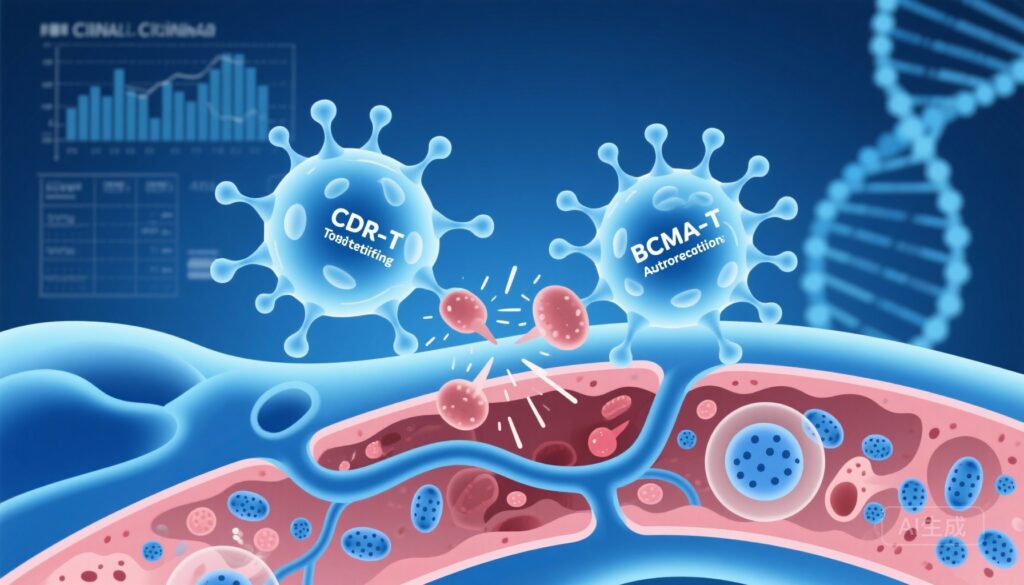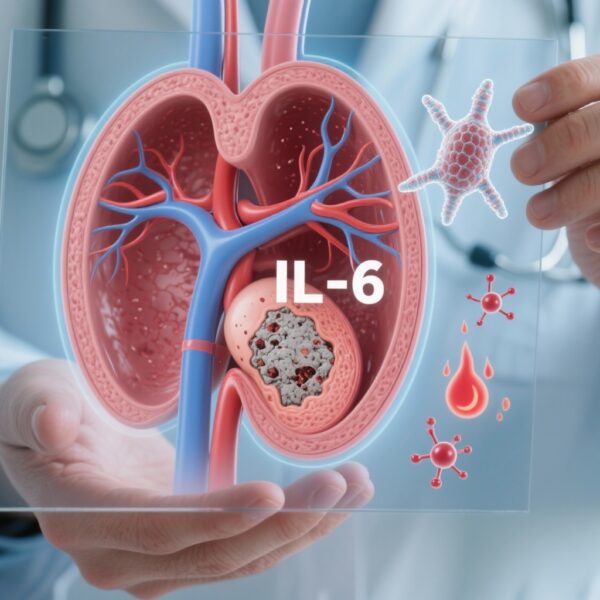Highlights
– Co-infusion of autologous anti‑CD19 and anti‑BCMA CAR‑T cells induced LLDAS and DORIS remission in 12/15 (80%) treatment‑refractory SLE patients by week 12 with a median follow‑up of 712 days.
– No dose‑limiting toxicities (DLTs) or treatment‑related deaths; grade 1 CRS was common (86.7%); grade ≥3 cytopenias (neutropenia 100%, thrombocytopenia 40%, anemia 13.3%) were reversible with supportive care.
– Multiomic analyses showed elimination of autoreactive CD19+ and CD19–BCMA+ clones, reconstitution of naive IgM/IgD B cells, and durable downregulation of interferon‑stimulated and BAFF‑dependent signatures — consistent with restored immune homeostasis.
Background: unmet need and biological rationale
Systemic lupus erythematosus (SLE) is a clinically heterogeneous autoimmune disease driven by autoantibody‑producing B‑lineage cells, immune complex formation, and type I interferon pathway activation. While many patients respond to conventional immunosuppression and targeted biologics (e.g., anti‑BAFF, anti‑IFN therapies), a subset remain treatment‑refractory with active, organ‑threatening disease and poor quality of life. Long‑lived bone marrow plasma cells are resistant to many B‑cell–depleting strategies because they often lack CD19, the canonical target of many therapies, while expressing BCMA (B cell maturation antigen). Conversely, circulating and tissue‑resident autoreactive B cells express CD19 but not necessarily BCMA. This compartmental separation provides a mechanistic rationale for dual targeting: CD19 to eliminate the CD19+ B‑cell compartment (including plasmablasts and memory B cells) and BCMA to deplete long‑lived plasma cells that sustain pathogenic autoantibody production.
Study design
The report by Feng et al. (Nat Med 2025) describes an ongoing phase 1 dose‑escalation trial (ClinicalTrials.gov: NCT05030779) of co‑infused autologous anti‑CD19 and anti‑BCMA CAR‑T cells in patients with treatment‑refractory SLE. Key features:
- Population: 15 patients (14 female, 1 male) with refractory SLE disease despite standard therapies.
- Intervention: Autologous CAR‑T manufacturing followed by fludarabine/cyclophosphamide lymphodepletion and co‑infusion of anti‑CD19 and anti‑BCMA CAR‑T products (dose escalation schema applied).
- Primary endpoints: Dose‑limiting toxicities (DLTs) within 28 days and adverse events within 12 weeks.
- Key secondary endpoints: Achievement of Lupus Low Disease Activity State (LLDAS) and DORIS remission within 12 weeks, and in vivo CAR‑T persistence within 24 weeks.
- Exploratory endpoints: Duration and kinetics of peripheral B‑cell depletion and recovery, immune reconstitution, serial autoantibody titers, and serum immunoglobulin concentrations.
Key findings
Safety
No DLTs were observed across the cohort and there were no treatment‑related deaths. Cytokine release syndrome (CRS) occurred in 86.7% of patients but was limited to grade 1 in severity. Notably, no neurotoxicity was reported. The most frequent grade ≥3 adverse events were hematologic: neutropenia in 100% of patients, thrombocytopenia in 40%, and anemia in 13.3%; these events were reversible with standard supportive measures. The overall safety profile is consistent with expected toxicities of lymphodepleting chemotherapy and CAR‑T therapy but—with the important distinction of low CRS grade and absence of neurotoxicity—appears favorable in this small, heavily pretreated autoimmune cohort.
Short‑term efficacy (clinical endpoints)
By week 12 after infusion, 12 of 15 patients (80%) met both LLDAS and DORIS remission criteria. This is a striking signal in a refractory population, especially given the rapidity of response following a single cellular therapy administration. The trial reports sustained clinical benefit over a median follow‑up of 712 days (range 613–1,134 days), suggesting durability beyond the early post‑treatment window.
Biologic correlates and multiomic findings
Comprehensive multiomic analyses were performed to characterize the mechanism of response. Key observations include:
- Elimination of autoreactive clones spanning CD19+ and CD19–BCMA+ compartments, consistent with effective depletion of both circulating B cells and bone marrow plasma cells.
- Reconstitution of a naive B‑cell pool dominated by IgM/IgD phenotype rather than autoreactive memory clones, suggesting a reset of the B‑cell repertoire.
- Durable downregulation of interferon‑stimulated genes and BAFF‑dependent transcriptional signatures, which are commonly upregulated in active SLE and correlate with disease activity.
- Longitudinal monitoring in a subset (three patients followed for 1 year) showed sustained eradication of pathogenic clones, raising the possibility of a curative effect in at least some patients.
Expert interpretation and mechanistic plausibility
The co‑targeting strategy addresses a long‑standing biologic obstacle in SLE therapy: persistence of long‑lived autoreactive plasma cells in the bone marrow that escape CD19‑directed therapies and continue to produce pathogenic autoantibodies. BCMA is highly expressed on plasma cells, and BCMA‑targeted modalities (including antibody–drug conjugates and CAR‑T cells) have shown activity in plasma‑cell driven diseases. The combined CD19/BCMA approach therefore provides a two‑pronged eradication of the autoreactive B‑lineage reservoir: CD19 CAR‑T kills circulating B cells and plasmablasts, while BCMA CAR‑T targets long‑lived, CD19‑negative plasma cells. The observed restoration of a naive, non‑autoreactive B‑cell repertoire and normalization of interferon and BAFF signatures are biologically coherent with removal of the core drivers of lupus autoimmunity.
Limitations and caveats
Important limitations must temper enthusiasm despite compelling early results:
- Phase 1, nonrandomized, small cohort: The study was designed to assess safety and signal efficacy but not to provide definitive comparative effectiveness against standard care or other targeted agents.
- Selection and center effects: Details on selection criteria, prior therapies, organ involvement, and center experience will influence generalizability.
- Infection risk and hypogammaglobulinemia: Long‑term consequences of profound B‑cell and plasma‑cell depletion include hypogammaglobulinemia and infection susceptibility. The report notes immunoglobulin monitoring, but broader infectious outcomes and need for replacement immunoglobulin require systematic follow‑up in larger cohorts.
- Cost, complexity, and access: Autologous CAR‑T manufacturing, lymphodepletion, and specialized supportive care currently limit scalability compared with conventional biologics.
- Durability and relapse: Although median follow‑up was substantial (712 days) and a subset showed 1‑year eradication of pathogenic clones, longer follow‑up across more patients is necessary to establish the proportion of patients achieving durable, treatment‑free remission or ‘cure’.
Clinical and research implications
These results provide proof‑of‑concept that cellular therapies can reset autoimmune immunity in refractory SLE. Practical implications include:
- Patient selection: Patients with truly refractory disease and high risk of morbidity may be prioritized for early phase cellular therapy trials; biomarkers (autoantibody specificity, bone marrow plasma‑cell burden, BAFF/IFN signatures) could help select those most likely to benefit.
- Monitoring and supportive care: Protocols for antimicrobial prophylaxis, immunoglobulin replacement, vaccination timing, and long‑term monitoring of B‑cell reconstitution should be standardized in future protocols.
- Trial design: Randomized, controlled phase 2/3 studies are needed to compare dual CAR‑T with best available therapy, to refine dosing, and to evaluate durability, quality of life, organ‑specific outcomes, and cost‑effectiveness.
- Mechanistic studies: Serial multiomic profiling may identify correlates of durable remission versus relapse and could guide personalized maintenance strategies (e.g., targeted biologics if minimal residual autoreactivity persists).
Conclusion
Co‑infusion of autologous anti‑CD19 and anti‑BCMA CAR‑T cells shows a favorable safety profile and promising clinical efficacy in this phase 1 cohort of treatment‑refractory SLE patients, with high rates of early remission and biologic evidence of eradication of pathogenic B‑lineage clones. The data support further development and larger, controlled trials to determine whether this approach can provide a durable, possibly curative, option for patients with refractory SLE. Careful attention to long‑term infectious risk, immunoglobulin replacement strategies, and equitable access will be essential as the field moves forward.
Funding and trial registration
The report includes funding and institutional support details in the original publication. ClinicalTrials.gov identifier: NCT05030779.
References
- Feng J, Huo D, Hong R, et al. Co‑infusion of CD19‑targeting and BCMA‑targeting CAR‑T cells for treatment‑refractory systemic lupus erythematosus: a phase 1 trial. Nat Med. 2025 Sep 24. doi:10.1038/s41591-025-03937-8. PMID: 40993243.
Thumbnail prompt (AI image generation)
A stylized clinical-scientific illustration showing two engineered CAR-T cells (one labeled CD19-targeting, one labeled BCMA-targeting) engaging and eliminating autoreactive B cells and plasma cells within a schematic human lymph node and bone marrow; include a subtle medical chart overlay and DNA helix in background; cool clinical blue/teal palette, high detail, informative and modern.



